

You are using an out of date browser. It may not display this or other websites correctly.
You should upgrade or use an alternative browser.
You should upgrade or use an alternative browser.
dbltree
Super Moderator
Re: Openings for bedding areas
Summertime now and the results of edgefeathering some areas the past few years are starting to show with plenty of browse, berries and cover for small wildlife as well.
Lots of blackberries...

I didn't eat any... /forum/images/%%GRAEMLIN_URL%%/wink.gif

You can see the mass of undergrowth that flourished when the trees were toppled.

Multifora Rose are dying but being quickly replaced by other species such as this blackberry

Elderberry shrubs pop up

Holding a plethora of fruits

Sumac fills in some spots

All of these pics show browse, fruit and cover that is available to deer and other wildlife that was not there before. Adult trees that were not mast producing offer nothing to deer.
We are frantically searching for the "ultimate" food plot that surely will produce monster bucks and lure them within range however we would be sadly mistaken if we put to much weight to such thinking.
Deer need natural forage, they need cover and escape areas and the larger and more abundundant those areas the more likely we can hold mature bucks.
Your foodplots will help hold does and hence bucks during the rut but mature bucks don't survive because of some "Mega" Clover or "Monster Brassica" mix. They survive because they have safe bedding and browse areas that keep them alive when the slugs start flying.
Always keep in mind the importance of timbered areas and use a chainsaw and burning as tools to enhance those areas for deer and other wildlife /forum/images/%%GRAEMLIN_URL%%/smile.gif
Summertime now and the results of edgefeathering some areas the past few years are starting to show with plenty of browse, berries and cover for small wildlife as well.
Lots of blackberries...

I didn't eat any... /forum/images/%%GRAEMLIN_URL%%/wink.gif

You can see the mass of undergrowth that flourished when the trees were toppled.

Multifora Rose are dying but being quickly replaced by other species such as this blackberry

Elderberry shrubs pop up

Holding a plethora of fruits

Sumac fills in some spots

All of these pics show browse, fruit and cover that is available to deer and other wildlife that was not there before. Adult trees that were not mast producing offer nothing to deer.
We are frantically searching for the "ultimate" food plot that surely will produce monster bucks and lure them within range however we would be sadly mistaken if we put to much weight to such thinking.
Deer need natural forage, they need cover and escape areas and the larger and more abundundant those areas the more likely we can hold mature bucks.
Your foodplots will help hold does and hence bucks during the rut but mature bucks don't survive because of some "Mega" Clover or "Monster Brassica" mix. They survive because they have safe bedding and browse areas that keep them alive when the slugs start flying.
Always keep in mind the importance of timbered areas and use a chainsaw and burning as tools to enhance those areas for deer and other wildlife /forum/images/%%GRAEMLIN_URL%%/smile.gif
Re: Openings for bedding areas
Does multifora rose serve any good purpose? I got a 15 acre timber that was logged about 3 years ago and it was thick then now there are places that would make a rabbit cringe. I'm wanting to kill it and plant some big bluestem in some areas. I know I'll never get rid of it all but would be nice to keep it down some. I've necer seen a deer bed down in it maybe by it but there are plenty of tree tops they seem to enjoy allot more. Have noticed some blackberries to which I don't mind but they're surounded by multifora rose so not doing much good a bird might be able to get to them. This sound like a good idea?
Does multifora rose serve any good purpose? I got a 15 acre timber that was logged about 3 years ago and it was thick then now there are places that would make a rabbit cringe. I'm wanting to kill it and plant some big bluestem in some areas. I know I'll never get rid of it all but would be nice to keep it down some. I've necer seen a deer bed down in it maybe by it but there are plenty of tree tops they seem to enjoy allot more. Have noticed some blackberries to which I don't mind but they're surounded by multifora rose so not doing much good a bird might be able to get to them. This sound like a good idea?
dbltree
Super Moderator
Re: Openings for bedding areas
<div class="ubbcode-block"><div class="ubbcode-header">Quote:</div><div class="ubbcode-body">Does multifora rose serve any good purpose? </div></div>
Sure...if your a rabbit! /forum/images/%%GRAEMLIN_URL%%/grin.gif
MFR is on it's way out as disease moves in and there are better plants for sure. You can spray it and/or burn it and start replacing it with native grass or native shrubs.
I know much of it is dying at a rapid pace around my area /forum/images/%%GRAEMLIN_URL%%/smile.gif
<div class="ubbcode-block"><div class="ubbcode-header">Quote:</div><div class="ubbcode-body">Does multifora rose serve any good purpose? </div></div>
Sure...if your a rabbit! /forum/images/%%GRAEMLIN_URL%%/grin.gif
MFR is on it's way out as disease moves in and there are better plants for sure. You can spray it and/or burn it and start replacing it with native grass or native shrubs.
I know much of it is dying at a rapid pace around my area /forum/images/%%GRAEMLIN_URL%%/smile.gif
dbltree
Super Moderator
Re: Openings for bedding areas
<div class="ubbcode-block"><div class="ubbcode-header">Quote:</div><div class="ubbcode-body">Does burning it work good sounds allot cheaper than the spray </div></div>
it might take several years of burning it at the right stage in the spring if you have enough fuel to get to burn well.
Spray will be deadlier and quicker no doubt but you can cover a lot of ground in a short time with fire.
The disease is slowly spreading northward so it hasn't hit every area yet.
<div class="ubbcode-block"><div class="ubbcode-header">Quote:</div><div class="ubbcode-body">Does burning it work good sounds allot cheaper than the spray </div></div>
it might take several years of burning it at the right stage in the spring if you have enough fuel to get to burn well.
Spray will be deadlier and quicker no doubt but you can cover a lot of ground in a short time with fire.
The disease is slowly spreading northward so it hasn't hit every area yet.
Skully
PMA Member
Re: Openings for bedding areas
Does Sumac have much nutritional value for deer? I have a back field that is over-run with those volunteer trees. They are at a mowable height now but can really sprout if you let them go a couple years. I know they make dense bedding cover but are they worth leaving if they keep trying to take over my CRP acres?
Does Sumac have much nutritional value for deer? I have a back field that is over-run with those volunteer trees. They are at a mowable height now but can really sprout if you let them go a couple years. I know they make dense bedding cover but are they worth leaving if they keep trying to take over my CRP acres?
dbltree
Super Moderator
Re: Openings for bedding areas
<div class="ubbcode-block"><div class="ubbcode-header">Quote:</div><div class="ubbcode-body">I know they make dense bedding cover but are they worth leaving if they keep trying to take over my CRP acres? </div></div>
No...I would keep them mowed back and out of your CRP. They serve a purpose in their place but that place is not in our CRP fields! /forum/images/%%GRAEMLIN_URL%%/wink.gif
<div class="ubbcode-block"><div class="ubbcode-header">Quote:</div><div class="ubbcode-body">I know they make dense bedding cover but are they worth leaving if they keep trying to take over my CRP acres? </div></div>
No...I would keep them mowed back and out of your CRP. They serve a purpose in their place but that place is not in our CRP fields! /forum/images/%%GRAEMLIN_URL%%/wink.gif
dbltree
Super Moderator
Re: Openings for bedding areas
I didn't go "crashing" around in the cut over/hinge cut bedding areas but I did slip up to the edge and snap a few pics for a bit of an update.
This one is in low ground and boy has it gotten thick!

The rich, moist soil and types of trees growing there are conducive to making a thick bedding/browsing area.

That spot is right adjacent to a feeding area and deer pop put of there like crazy every evening! /forum/images/%%GRAEMLIN_URL%%/cool.gif
These pics are from the hardwood/shagbark hickory cuttings on a dry ridge. It is slower to re-grow but deer love this spot that used to look like this...

Now...standing on the "outside looking in" you can see it's looking different..

The jumble of tops and trees along with new growth make a jungle that combined with the ridge make an awesome bedding spot!

The hickories do not get the stump regrowth that some trees do, but the blackberries and other shrubs that come up provide great browse and cover.

This picture again shows how open and devoid of food or cover that this ridge had been.

This picture, again taken from far back, shows how I cut a series of -V- shaped openings into the timbered ridge. Eventually I will hinge cut the "inverted -V-'s" to have a succession of different aged cover.

You can take a hand seeder and spread fertilizer in the new opening when spring comes, just to speed growth and make the new growth even more attractive.
Many people don't know just how attractive blackberries are to deer as they will almost always stop and feed on them after a night of foraging in the food plots.
Then they bed down and spend hours in these bedding areas. As I approached these a large group of deer bounded away. This is the whole idea, create safe secure bedding/browsing areas that will hold our deer at home.
Remember...deer are ruminants and need to forage every 4 hours, so they will prefer to bed where they can browse right in their bedroom as needed.
Long about Feb and March I'll start on a new spot, using caution not to kill good mast producing trees such as oaks. /forum/images/%%GRAEMLIN_URL%%/smile.gif
I didn't go "crashing" around in the cut over/hinge cut bedding areas but I did slip up to the edge and snap a few pics for a bit of an update.
This one is in low ground and boy has it gotten thick!

The rich, moist soil and types of trees growing there are conducive to making a thick bedding/browsing area.

That spot is right adjacent to a feeding area and deer pop put of there like crazy every evening! /forum/images/%%GRAEMLIN_URL%%/cool.gif
These pics are from the hardwood/shagbark hickory cuttings on a dry ridge. It is slower to re-grow but deer love this spot that used to look like this...

Now...standing on the "outside looking in" you can see it's looking different..

The jumble of tops and trees along with new growth make a jungle that combined with the ridge make an awesome bedding spot!

The hickories do not get the stump regrowth that some trees do, but the blackberries and other shrubs that come up provide great browse and cover.

This picture again shows how open and devoid of food or cover that this ridge had been.

This picture, again taken from far back, shows how I cut a series of -V- shaped openings into the timbered ridge. Eventually I will hinge cut the "inverted -V-'s" to have a succession of different aged cover.

You can take a hand seeder and spread fertilizer in the new opening when spring comes, just to speed growth and make the new growth even more attractive.
Many people don't know just how attractive blackberries are to deer as they will almost always stop and feed on them after a night of foraging in the food plots.
Then they bed down and spend hours in these bedding areas. As I approached these a large group of deer bounded away. This is the whole idea, create safe secure bedding/browsing areas that will hold our deer at home.
Remember...deer are ruminants and need to forage every 4 hours, so they will prefer to bed where they can browse right in their bedroom as needed.
Long about Feb and March I'll start on a new spot, using caution not to kill good mast producing trees such as oaks. /forum/images/%%GRAEMLIN_URL%%/smile.gif
dbltree
Super Moderator
Re: Openings for bedding areas
Hunting season is all but over and many landowners will be thinking about improving their property by creating bedding areas and openings that will increase browse.
It's important to really think and plan through what you plan to do and why before firing up the chainsaw.
First, if you hope to create areas where mature bucks might bed, we need to think like the "hunted" rather then the "hunter". /forum/images/%%GRAEMLIN_URL%%/wink.gif
Suppose you were in a paintball game only...without a gun! Where would you hide? Would you want to be someplace where you could see danger coming? Would you want an escape route?
Remember...your only protection is your survival instincts...your ability to hide and flee!
I won't pretend to know exactly what goes on in mature whitetail bucks mind but based on some common sense principals and years of observation there are a couple things to consider.
1)Sight A buck is generally going to want to see danger approaching which means what? Think in terms of a hill, ridge or slope where he will feel safe in his ability to survey his surroundings for approaching danger.
2) Cover A mature buck is going to want some type of cover and this we can provide in the form of hinge cut trees and their tops. Ever walk into a recently logged woodlot? You'll find lone beds tucked up next to those oak tops overlooking a valley or draw.
The tree top and tree log itself provides cover not only as he lies in his bed but he can keep that top between him and danger should he need to flee. (Imagine paintballs splatting against tree limbs as you haul outta there as your "pursuer" approaches /forum/images/%%GRAEMLIN_URL%%/wink.gif )
3) Safety and Solitude Mature bucks, unlike one and two year olds, seem to prefer solitude, in otherwords they want to stay away from the crowd. Think about this aspect when working on a "buck bed" versus a larger "bedding area" for doe groups.
Think about a buck bed in terms of an individual situation. Think about yourself, one person...hiding from a group of guys with paintball guns. You know that your "survival" depends on yourself and not being distracted by others.
Any noise, movement or smell...you want to know for positive what those mean and a "group" all around you distracts from that.
You don't want to be by a road, a house or any commotion that will distract you from your only job...<span style='font-size: 11pt'>surviving</span>
Using arial pics and our own observations we can find a quiet, safe place on a ridge or slope that has some cull or junk trees on it. Now hinge them 2-4 ft above the ground if possible in a -V- shape or slight curve so to create a shield on the up hill side and a view of the slope away from him.
Trees hinged slightly down the slope that he can see over or thru but that will not impede his escape make it even more attractive.
I have found that the principle is much the same in my switchgrass, bucks bed on a hill where they can see through the switchgrass but yet if I jump him...he's gone in a flash in the thick prairiegrass. Me being the surprised one... /forum/images/%%GRAEMLIN_URL%%/blush.gif /forum/images/%%GRAEMLIN_URL%%/grin.gif
So you made a spot that a mature buck can't resist...how are going to harvest that buck this fall??? /forum/images/%%GRAEMLIN_URL%%/confused.gif
Patience grasshopper...my two fingers are plum wore out... /forum/images/%%GRAEMLIN_URL%%/blush.gif /forum/images/%%GRAEMLIN_URL%%/grin.gif
Hunting season is all but over and many landowners will be thinking about improving their property by creating bedding areas and openings that will increase browse.
It's important to really think and plan through what you plan to do and why before firing up the chainsaw.
First, if you hope to create areas where mature bucks might bed, we need to think like the "hunted" rather then the "hunter". /forum/images/%%GRAEMLIN_URL%%/wink.gif
Suppose you were in a paintball game only...without a gun! Where would you hide? Would you want to be someplace where you could see danger coming? Would you want an escape route?
Remember...your only protection is your survival instincts...your ability to hide and flee!
I won't pretend to know exactly what goes on in mature whitetail bucks mind but based on some common sense principals and years of observation there are a couple things to consider.
1)Sight A buck is generally going to want to see danger approaching which means what? Think in terms of a hill, ridge or slope where he will feel safe in his ability to survey his surroundings for approaching danger.
2) Cover A mature buck is going to want some type of cover and this we can provide in the form of hinge cut trees and their tops. Ever walk into a recently logged woodlot? You'll find lone beds tucked up next to those oak tops overlooking a valley or draw.
The tree top and tree log itself provides cover not only as he lies in his bed but he can keep that top between him and danger should he need to flee. (Imagine paintballs splatting against tree limbs as you haul outta there as your "pursuer" approaches /forum/images/%%GRAEMLIN_URL%%/wink.gif )
3) Safety and Solitude Mature bucks, unlike one and two year olds, seem to prefer solitude, in otherwords they want to stay away from the crowd. Think about this aspect when working on a "buck bed" versus a larger "bedding area" for doe groups.
Think about a buck bed in terms of an individual situation. Think about yourself, one person...hiding from a group of guys with paintball guns. You know that your "survival" depends on yourself and not being distracted by others.
Any noise, movement or smell...you want to know for positive what those mean and a "group" all around you distracts from that.
You don't want to be by a road, a house or any commotion that will distract you from your only job...<span style='font-size: 11pt'>surviving</span>
Using arial pics and our own observations we can find a quiet, safe place on a ridge or slope that has some cull or junk trees on it. Now hinge them 2-4 ft above the ground if possible in a -V- shape or slight curve so to create a shield on the up hill side and a view of the slope away from him.
Trees hinged slightly down the slope that he can see over or thru but that will not impede his escape make it even more attractive.
I have found that the principle is much the same in my switchgrass, bucks bed on a hill where they can see through the switchgrass but yet if I jump him...he's gone in a flash in the thick prairiegrass. Me being the surprised one... /forum/images/%%GRAEMLIN_URL%%/blush.gif /forum/images/%%GRAEMLIN_URL%%/grin.gif
So you made a spot that a mature buck can't resist...how are going to harvest that buck this fall??? /forum/images/%%GRAEMLIN_URL%%/confused.gif
Patience grasshopper...my two fingers are plum wore out... /forum/images/%%GRAEMLIN_URL%%/blush.gif /forum/images/%%GRAEMLIN_URL%%/grin.gif
dbltree
Super Moderator
Re: Creating funnels
I posted pics in the tree planting thread but I wanted to add a couple here for reference.
If I want to keep from getting shot...I want to be hidden but also be able to see danger. This pic is from ground level under some red cedars

Standing up however, this is my view...

So we use this princple when working on both buck and doe bedding areas. They need cover, but cover they can see thru laying down and that will "cover their back" as the flee.
Once we have established bedding areas however...what then? What can we do to better our odds of harvesting a mature buck that might choose the bedding areas we have so cleverly crafted for them. /forum/images/%%GRAEMLIN_URL%%/wink.gif
Notice the hinged trees in this pic...notice that by hinging we left the "log" up off the ground verus laying them down flat.
Would you want to walk thru that mess???

I use that principal to create funnels to make easy pathways that deer will follow and other then to bed, they won't veer from.
A mature buck traveling searching for does or venturing out to check a scrape line isn't interested in feeding...only traveling from point A to point B.
He's not going to waste energy and time so he cuts cross lots, often when things heat up, across open fields. Early on however he stays close to cover before dark or right after daylight slipping back to his bed.
Hard to kill that buck if he can go anywhere!
First obeserve, watch and learn, use TC's to locate sometimes little used runways along with potential stand sites. Then tip trees over in the same manner as for bedding only with no purpose other then to "guide" deer past stand sites.
Several things happen, not only will the "junk" force deer down the easy pathway but new browse will spring up, blackberries will emerge and all of that encourages deer to feed as they move back and forth to night time food sources.
We can make scrape lines along edges leading to plots where bucks will circle looking for does. Funnels leading to an exit from the woodlot or timber can be a great stand site.
Using edgefeathering we can make it difficult for deer to pop into a field just anywhere and also create great browse and small game cover along the field edge.
Deer are no different from us in that respect, we don't walk thru peoples yards, crawl over fences and shrubs and swim through someones pool...
We walk down the sidewalk...so make em a sidewalk so to speak. A safe travel corridor where they can travel quietly and feed as they go.
More then one, and stands with quiet easy access that will not disturb deer coming or going... /forum/images/%%GRAEMLIN_URL%%/cool.gif
Hinging trees isn't just "making a mess"...think about it from an old bucks perspective. Make him an easy chair with an easy route to the kitchen and "girlfriends".... /forum/images/%%GRAEMLIN_URL%%/wink.gif
I posted pics in the tree planting thread but I wanted to add a couple here for reference.
If I want to keep from getting shot...I want to be hidden but also be able to see danger. This pic is from ground level under some red cedars

Standing up however, this is my view...

So we use this princple when working on both buck and doe bedding areas. They need cover, but cover they can see thru laying down and that will "cover their back" as the flee.
Once we have established bedding areas however...what then? What can we do to better our odds of harvesting a mature buck that might choose the bedding areas we have so cleverly crafted for them. /forum/images/%%GRAEMLIN_URL%%/wink.gif
Notice the hinged trees in this pic...notice that by hinging we left the "log" up off the ground verus laying them down flat.
Would you want to walk thru that mess???

I use that principal to create funnels to make easy pathways that deer will follow and other then to bed, they won't veer from.
A mature buck traveling searching for does or venturing out to check a scrape line isn't interested in feeding...only traveling from point A to point B.
He's not going to waste energy and time so he cuts cross lots, often when things heat up, across open fields. Early on however he stays close to cover before dark or right after daylight slipping back to his bed.
Hard to kill that buck if he can go anywhere!
First obeserve, watch and learn, use TC's to locate sometimes little used runways along with potential stand sites. Then tip trees over in the same manner as for bedding only with no purpose other then to "guide" deer past stand sites.
Several things happen, not only will the "junk" force deer down the easy pathway but new browse will spring up, blackberries will emerge and all of that encourages deer to feed as they move back and forth to night time food sources.
We can make scrape lines along edges leading to plots where bucks will circle looking for does. Funnels leading to an exit from the woodlot or timber can be a great stand site.
Using edgefeathering we can make it difficult for deer to pop into a field just anywhere and also create great browse and small game cover along the field edge.
Deer are no different from us in that respect, we don't walk thru peoples yards, crawl over fences and shrubs and swim through someones pool...
We walk down the sidewalk...so make em a sidewalk so to speak. A safe travel corridor where they can travel quietly and feed as they go.
More then one, and stands with quiet easy access that will not disturb deer coming or going... /forum/images/%%GRAEMLIN_URL%%/cool.gif
Hinging trees isn't just "making a mess"...think about it from an old bucks perspective. Make him an easy chair with an easy route to the kitchen and "girlfriends".... /forum/images/%%GRAEMLIN_URL%%/wink.gif
dbltree
Super Moderator
Re: Creating funnels and succession
A friend wonderd why I mentioned earlier that I made cuts into the timber, from the edge inward in -V- shapes.
I do this (cutting in the formation of a saw cut) so as to have a constant succession of bedding/browse growth.
I don't want to cut the whole place down, nor do I want to cut just one spot that will soon mature and no longer be attractive to deer.
So the "shape" perhaps isn't that important except that -V-'s tend to become funnels and help me get deer moving in or out in narrow areas.
What is more important to me is that as I move down a timber/field line over a period of years I'm creating a constant succession of new browse, new openings, new bedding areas, while previous cuts begin to mature and change.
In time I will cut the inverted -V-s let standing when I made the orginal cuts.
This video is of a young buck I filmed while hunting this last fall in an area that I hinge cut and created a funnel runway. Shortly after another larger buck came thru but it was to dark and didn't show up well on video.

You can easily see the "mess" hinging leaves and why it should never be misconstrued as "Timber Stand Improvment"... /forum/images/%%GRAEMLIN_URL%%/grin.gif
Just remember to pic areas that have trees of little or poor timber value before you start your "chainsaw massacre"... /forum/images/%%GRAEMLIN_URL%%/eek.gif
A friend wonderd why I mentioned earlier that I made cuts into the timber, from the edge inward in -V- shapes.
I do this (cutting in the formation of a saw cut) so as to have a constant succession of bedding/browse growth.
I don't want to cut the whole place down, nor do I want to cut just one spot that will soon mature and no longer be attractive to deer.
So the "shape" perhaps isn't that important except that -V-'s tend to become funnels and help me get deer moving in or out in narrow areas.
What is more important to me is that as I move down a timber/field line over a period of years I'm creating a constant succession of new browse, new openings, new bedding areas, while previous cuts begin to mature and change.
In time I will cut the inverted -V-s let standing when I made the orginal cuts.
This video is of a young buck I filmed while hunting this last fall in an area that I hinge cut and created a funnel runway. Shortly after another larger buck came thru but it was to dark and didn't show up well on video.

You can easily see the "mess" hinging leaves and why it should never be misconstrued as "Timber Stand Improvment"... /forum/images/%%GRAEMLIN_URL%%/grin.gif
Just remember to pic areas that have trees of little or poor timber value before you start your "chainsaw massacre"... /forum/images/%%GRAEMLIN_URL%%/eek.gif
dbltree
Super Moderator
Re: Bedding spots and trail manipulation
Some pics of how we can create bedding spots and also manipulate runways to funnel deer through certain areas.
This a natural windfall that deer have been using as a screen on a hillside to safely bed and while natural, we can create the same situation.
You can see the deer bed behind this windfall

A second bed in the same spot

I got down in this spot as if I were the deer...hidden but able to see approaching danger...

Another bed on the outer edge of the windfall

On bottom ground regrowth is faster and it thickens up sooner

Deer have to funnel around the fallen trees

Blackberries abound in the opened up area

More edgefeathering that blocked up runways coming thru that area


Lot's of regrowth now on this 3 yr old stump

A little time and effor with a chainsaw can do all kinds of great things in your habitat program but I suggest doing Timber Stand Improvment first so that you don't kill any valuable crop trees! /forum/images/%%GRAEMLIN_URL%%/smile.gif
Here's a great article on cutting to provide deer browse:
Cutting Browse for Deer Feeding
Below is a list from this link on Winter Deer Foods
<div class="ubbcode-block"><div class="ubbcode-header">Quote:</div><div class="ubbcode-body">Preferred or Best Liked
Cedar, white or arborvitae Yew Apple
Sassafras Mountain maple Striped maple*
Red maple Witch hobble Flowering dogwood
Alternate leaved dogwood Basswood Staghorn sumac
Wintergreen
Second Choice
Elderberry Red berried elder Mountain ash
Highbush cranberry Highbush blueberry Willow*
Silky dogwood Red osier dogwood Honeysuckle
Nannyberry Cucumber tree Hemlock
Wild raisin Arbutus
Readily Eaten
White ash Sugar maple Oaks*
Black birch Yellow birch Hickory
American chestnut Black cherry Witch hazel
Spicebush Choke cherry Elm
Black walnut Shadbush, Winterberry Lowbush blueberry
Butternut Black ash Hazelnut
Wild grape Bush honeysuckle Leatherwood
Starvation or Poor Food
Scotch pine** Pitch pine** White pine**
Red pine** Beech Aspen or poplar
Mountain laurel** Rhododendron** Gray birch
Paper birch Musclewood (Blue beech) Ironwood (Hop hornbeam)
Spruces Alder Black locust
Grey-stemmed dogwood Red cedar Balsam**
Raspberry and blackberry Sweet fern Pin cherry
Sheep laurel Tamarack Gooseberry (current)*
Buckthorn Hawthorn
</div></div>
Some pics of how we can create bedding spots and also manipulate runways to funnel deer through certain areas.
This a natural windfall that deer have been using as a screen on a hillside to safely bed and while natural, we can create the same situation.
You can see the deer bed behind this windfall

A second bed in the same spot

I got down in this spot as if I were the deer...hidden but able to see approaching danger...

Another bed on the outer edge of the windfall

On bottom ground regrowth is faster and it thickens up sooner

Deer have to funnel around the fallen trees

Blackberries abound in the opened up area

More edgefeathering that blocked up runways coming thru that area


Lot's of regrowth now on this 3 yr old stump

A little time and effor with a chainsaw can do all kinds of great things in your habitat program but I suggest doing Timber Stand Improvment first so that you don't kill any valuable crop trees! /forum/images/%%GRAEMLIN_URL%%/smile.gif
Here's a great article on cutting to provide deer browse:
Cutting Browse for Deer Feeding
Below is a list from this link on Winter Deer Foods
<div class="ubbcode-block"><div class="ubbcode-header">Quote:</div><div class="ubbcode-body">Preferred or Best Liked
Cedar, white or arborvitae Yew Apple
Sassafras Mountain maple Striped maple*
Red maple Witch hobble Flowering dogwood
Alternate leaved dogwood Basswood Staghorn sumac
Wintergreen
Second Choice
Elderberry Red berried elder Mountain ash
Highbush cranberry Highbush blueberry Willow*
Silky dogwood Red osier dogwood Honeysuckle
Nannyberry Cucumber tree Hemlock
Wild raisin Arbutus
Readily Eaten
White ash Sugar maple Oaks*
Black birch Yellow birch Hickory
American chestnut Black cherry Witch hazel
Spicebush Choke cherry Elm
Black walnut Shadbush, Winterberry Lowbush blueberry
Butternut Black ash Hazelnut
Wild grape Bush honeysuckle Leatherwood
Starvation or Poor Food
Scotch pine** Pitch pine** White pine**
Red pine** Beech Aspen or poplar
Mountain laurel** Rhododendron** Gray birch
Paper birch Musclewood (Blue beech) Ironwood (Hop hornbeam)
Spruces Alder Black locust
Grey-stemmed dogwood Red cedar Balsam**
Raspberry and blackberry Sweet fern Pin cherry
Sheep laurel Tamarack Gooseberry (current)*
Buckthorn Hawthorn
</div></div>
letemgrow
PMA Member
Re: Bedding spots and trail manipulation
DT, I have noticed on my place that the deer really love the cedar trees during an ice storm to bed under them. I cut most cedars, but leave the ones where the deer can bed in them and get the south facing winter sun.
On my place at least, I have found far more beds in tops I cut down where they can sun than anywhere else. Out of one shingle oak top on a south facing slope it looked like a covey of quail coming out of there while I was shed hunting in Feburary a couple years ago.
I also noticed while shed hunting the cedars on the north facing slopes in winter made it feel colder since no sun penetrated those areas.
DT, I have noticed on my place that the deer really love the cedar trees during an ice storm to bed under them. I cut most cedars, but leave the ones where the deer can bed in them and get the south facing winter sun.
On my place at least, I have found far more beds in tops I cut down where they can sun than anywhere else. Out of one shingle oak top on a south facing slope it looked like a covey of quail coming out of there while I was shed hunting in Feburary a couple years ago.
I also noticed while shed hunting the cedars on the north facing slopes in winter made it feel colder since no sun penetrated those areas.
dbltree
Super Moderator
Re: Bedding spots and trail manipulation
<div class="ubbcode-block"><div class="ubbcode-header">Quote:</div><div class="ubbcode-body">I have found far more beds in tops I cut down where they can sun than anywhere else. Out of one shingle oak top on a south facing slope it looked like a covey of quail coming out of there while I was shed hunting in Feburary a couple years ago.
</div></div>
I agree, south or east seems to work good for me and red cedars in an "open" sitaution where there is some grass and on a south facing slope works for me in the same manner.
Red cedars can for sure be too thick as in some pics I have posted. In those cases it's not my land so nothing I can do about it.
The nice thing about "tops" or hinged trees is that they get the warmth from sun but still have a hiding spot and escape cover! /forum/images/%%GRAEMLIN_URL%%/cool.gif
<div class="ubbcode-block"><div class="ubbcode-header">Quote:</div><div class="ubbcode-body">I have found far more beds in tops I cut down where they can sun than anywhere else. Out of one shingle oak top on a south facing slope it looked like a covey of quail coming out of there while I was shed hunting in Feburary a couple years ago.
</div></div>
I agree, south or east seems to work good for me and red cedars in an "open" sitaution where there is some grass and on a south facing slope works for me in the same manner.
Red cedars can for sure be too thick as in some pics I have posted. In those cases it's not my land so nothing I can do about it.
The nice thing about "tops" or hinged trees is that they get the warmth from sun but still have a hiding spot and escape cover! /forum/images/%%GRAEMLIN_URL%%/cool.gif
dbltree
Super Moderator
Re: Hinge Cuts for browse
Here's a few pics of hinge cuts that show a couple trees that have remained alive, sprouting new browse from the stump as well as growth from the original tree.
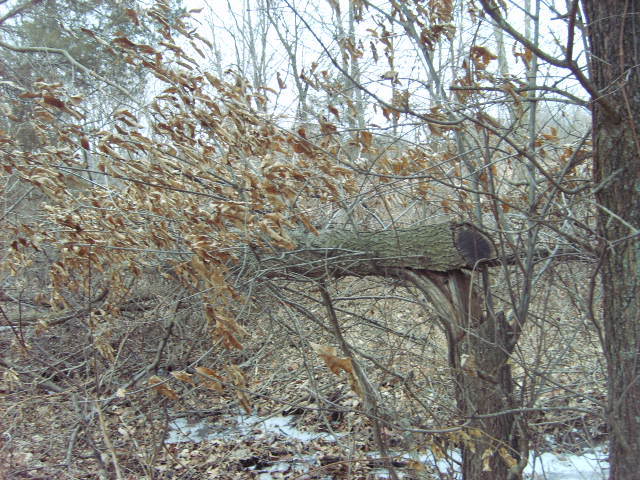
You can see how this things can be used to block runways to funnel deer as well as creating browse and bedding cover.
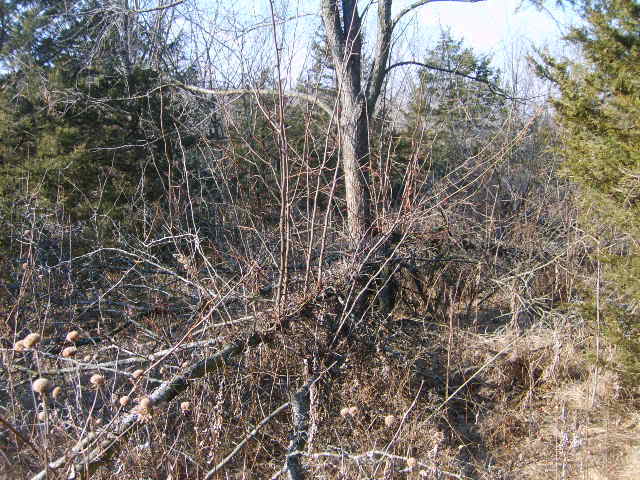
In this pic you can see the outer edges blocking off runways to a field but creating a thick area of cover within.
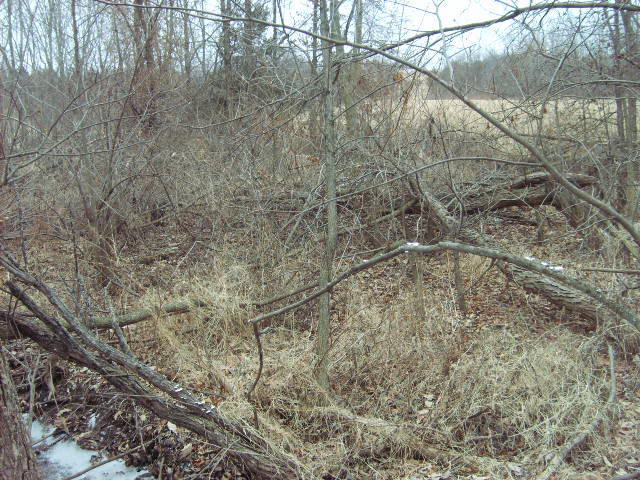
One can see the sprouts on these three yr old stumps in this area I opened up.

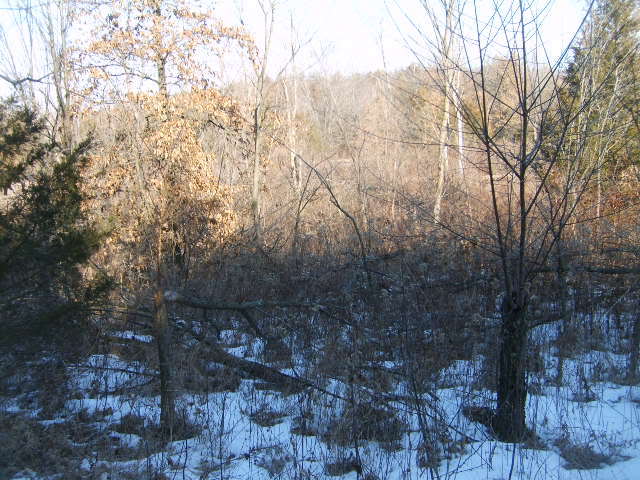
I always choose areas of "junk" or invasive type trees that have little or no timber or hard mast value.
Honey locust, soft maple, hickories, elms, box elders, ironwood are just a few on my list.
Here's a few pics of hinge cuts that show a couple trees that have remained alive, sprouting new browse from the stump as well as growth from the original tree.

You can see how this things can be used to block runways to funnel deer as well as creating browse and bedding cover.

In this pic you can see the outer edges blocking off runways to a field but creating a thick area of cover within.

One can see the sprouts on these three yr old stumps in this area I opened up.


I always choose areas of "junk" or invasive type trees that have little or no timber or hard mast value.
Honey locust, soft maple, hickories, elms, box elders, ironwood are just a few on my list.
dbltree
Super Moderator
Re: Funnels and runways
I fired up the chainsaw to work on a funnel and open up a single runway versus the multiple runways there when I started.
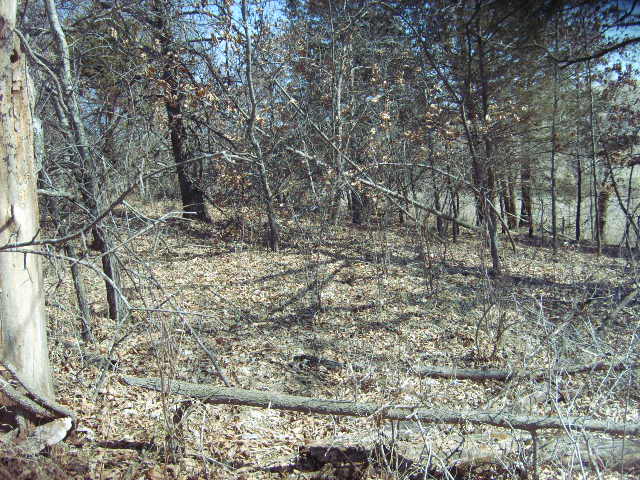
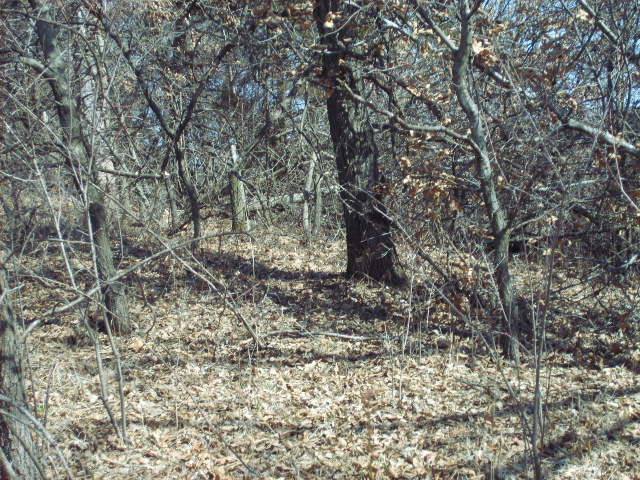
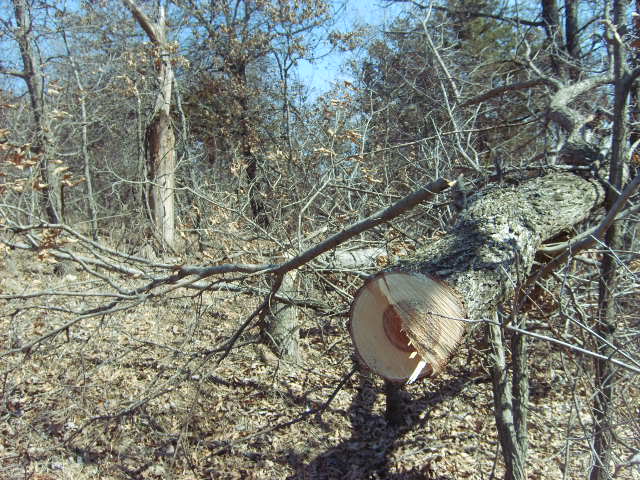
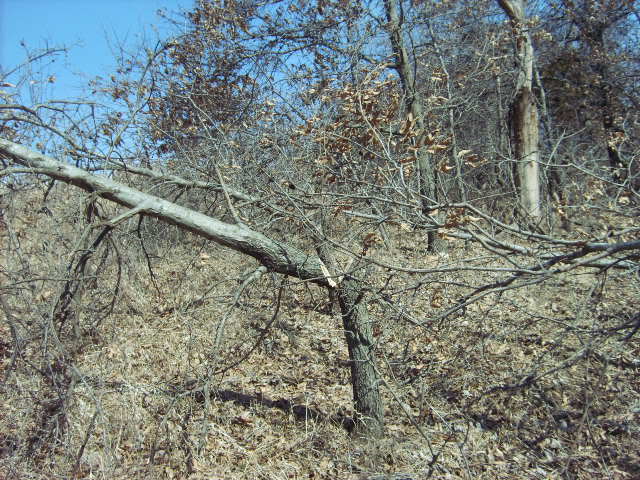
Here you can see the "mess" on either side and the "open" runway leading right to...
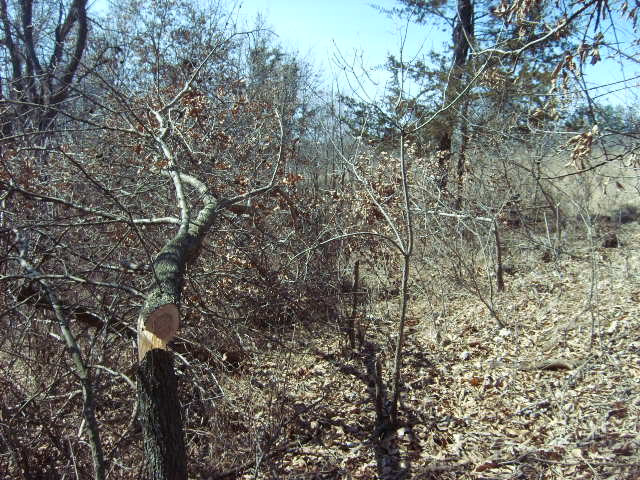
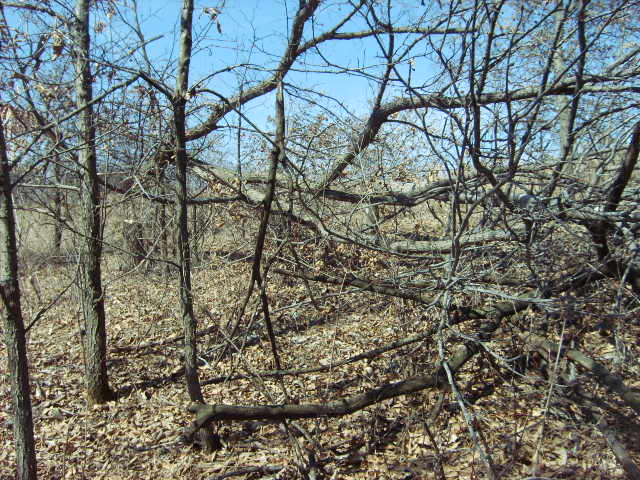
This shows the opened runway area
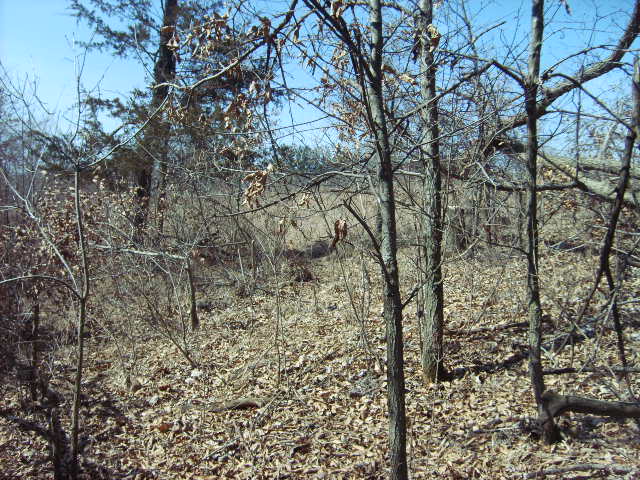
All hinge cut to "encourage" deer from traveling certain places and taking easier routes that will be...shall we say beneficial when it comes to filling the freezer...
Lot's of options when we use the chainsaw and put to work on junk trees to change travel corridors...
I fired up the chainsaw to work on a funnel and open up a single runway versus the multiple runways there when I started.




Here you can see the "mess" on either side and the "open" runway leading right to...


This shows the opened runway area

All hinge cut to "encourage" deer from traveling certain places and taking easier routes that will be...shall we say beneficial when it comes to filling the freezer...
Lot's of options when we use the chainsaw and put to work on junk trees to change travel corridors...
Last edited:
dbltree
Super Moderator
Some pics of more edgefeathering used in this case to "encourage" deer to use specific runways and increase browse along the field edge.
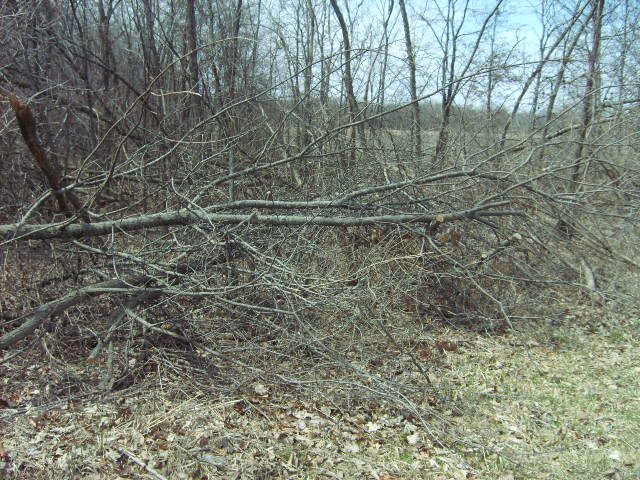
Mostly honey locust and silver maples hinged and then pushed around like a "living fence" along the field edge.
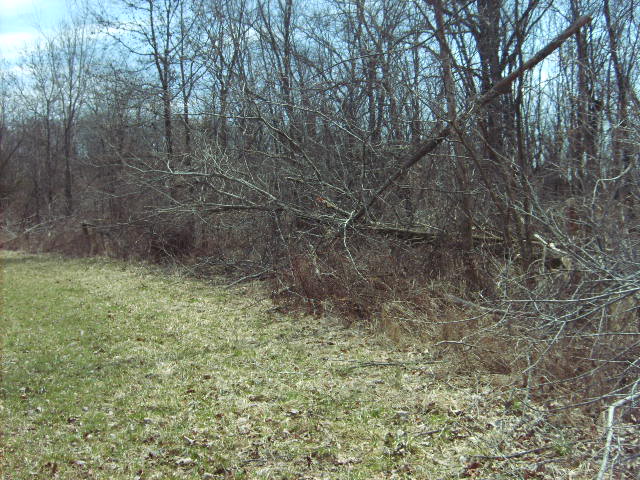
I also hinged every tree except the bur oaks in the low areas where I will hand plant white swamp oaks in the coming weeks
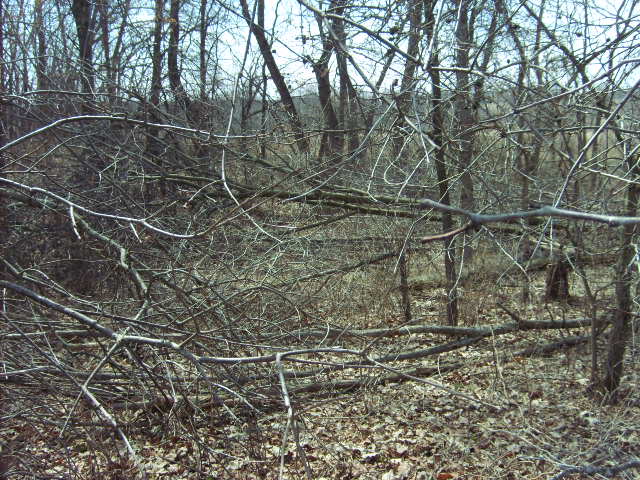
I just keep working on a transisition from maturing "cull" trees that offer nothing in the way of mast or bedding cover, to a situation that will offer bedding now and mast in the future.
Planting the swamp white oaks in the downed trees will help protect them from marauding bucks in the fall and in time replace trees with little or no value with those with high timber value.They will also provide a tremendous benefit to whitetails resulting from mast production in the future.
One can have a huge impact onyour habitat, literally in minutes just by using your chainsaw...carefully and wisely....

Mostly honey locust and silver maples hinged and then pushed around like a "living fence" along the field edge.

I also hinged every tree except the bur oaks in the low areas where I will hand plant white swamp oaks in the coming weeks

I just keep working on a transisition from maturing "cull" trees that offer nothing in the way of mast or bedding cover, to a situation that will offer bedding now and mast in the future.
Planting the swamp white oaks in the downed trees will help protect them from marauding bucks in the fall and in time replace trees with little or no value with those with high timber value.They will also provide a tremendous benefit to whitetails resulting from mast production in the future.
One can have a huge impact onyour habitat, literally in minutes just by using your chainsaw...carefully and wisely....